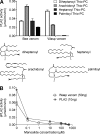Bee venom processes human skin lipids for presentation by CD1a
- PMID: 25584012
- PMCID: PMC4322046
- DOI: 10.1084/jem.20141505
Bee venom processes human skin lipids for presentation by CD1a
Abstract
Venoms frequently co-opt host immune responses, so study of their mode of action can provide insight into novel inflammatory pathways. Using bee and wasp venom responses as a model system, we investigated whether venoms contain CD1-presented antigens. Here, we show that venoms activate human T cells via CD1a proteins. Whereas CD1 proteins typically present lipids, chromatographic separation of venoms unexpectedly showed that stimulatory factors partition into protein-containing fractions. This finding was explained by demonstrating that bee venom-derived phospholipase A2 (PLA2) activates T cells through generation of small neoantigens, such as free fatty acids and lysophospholipids, from common phosphodiacylglycerides. Patient studies showed that injected PLA2 generates lysophospholipids within human skin in vivo, and polyclonal T cell responses are dependent on CD1a protein and PLA2. These findings support a previously unknown skin immune response based on T cell recognition of CD1a proteins and lipid neoantigen generated in vivo by phospholipases. The findings have implications for skin barrier sensing by T cells and mechanisms underlying phospholipase-dependent inflammatory skin disease.
© 2015 Bourgeois et al.
Figures







Comment in
-
Bee venom stirs up buzz in antigen presentation.J Exp Med. 2015 Feb 9;212(2):126. doi: 10.1084/jem.2122insight1. Epub 2015 Feb 2. J Exp Med. 2015. PMID: 25646264 Free PMC article. No abstract available.
References
-
- Argiolas A., and Pisano J.J.. 1983. Facilitation of phospholipase A2 activity by mastoparans, a new class of mast cell degranulating peptides from wasp venom. J. Biol. Chem. 258:13697–13702. - PubMed
Publication types
MeSH terms
Substances
Grants and funding
LinkOut - more resources
Full Text Sources
Other Literature Sources

